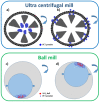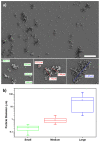Production and Characterization of Polyethylene Terephthalate Nanoparticles
- PMID: 34771306
- PMCID: PMC8587476
- DOI: 10.3390/polym13213745
Production and Characterization of Polyethylene Terephthalate Nanoparticles
Abstract
Microplastic (MP) pollution represents one of the biggest environmental problems that is further exacerbated by the continuous degradation in the marine environment of MPs to nanoplastics (NPs). The most diffuse plastics in oceans are commodity polymers, mainly thermoplastics widely used for packaging, such as polyethylene terephthalate (PET). However, the huge interest in the chemical vector role of micro/nanoplastics, their fate and negative effects on the environment and human health is still under discussion and the research is still sparse due also to the difficulties of sampling MPs and NPs from the environment or producing NPs in laboratory. Moreover, the research on MPs and NPs pollution relies on the availability of engineered nanoparticles similar to those present in the marine environment for toxicological, transport and adsorption studies in biological tissues as well as for wastewater remediation studies. This work aims to develop an easy, fast and scalable procedure for the production of representative model nanoplastics from PET pellets. The proposed method, based on a simple and economic milling process, has been optimized considering the peculiarities of the polymer. The results demonstrated the reliability of the method for preparing particle suspensions for aquatic microplastic research, with evident advantages compared to the present literature procedures, such as low cost, the absence of liquid nitrogen, the short production time, the high yield of the process, stability, reproducibility and polydisperse size distribution of the produced water dispersed nanometric PET.
Keywords: DSC; annealing; ball milling; marine plastics; microplastics; model nanoplastics; nanoplastic formation; ocean pollution; poly (ethylene terephthalate) nanoplastics.
Conflict of interest statement
The authors declare no conflict of interest.
Figures











Similar articles
-
The Minderoo-Monaco Commission on Plastics and Human Health.Ann Glob Health. 2023 Mar 21;89(1):23. doi: 10.5334/aogh.4056. eCollection 2023. Ann Glob Health. 2023. PMID: 36969097 Free PMC article. Review.
-
Micro- and nanoplastic toxicity: A review on size, type, source, and test-organism implications.Sci Total Environ. 2023 Jun 20;878:162954. doi: 10.1016/j.scitotenv.2023.162954. Epub 2023 Mar 21. Sci Total Environ. 2023. PMID: 36948318 Review.
-
Role of Structural Morphology of Commodity Polymers in Microplastics and Nanoplastics Formation: Fragmentation, Effects and Associated Toxicity in the Aquatic Environment.Rev Environ Contam Toxicol. 2021;259:123-169. doi: 10.1007/398_2021_80. Rev Environ Contam Toxicol. 2021. PMID: 34652560 Review.
-
Atmospheric microplastic and nanoplastic: The toxicological paradigm on the cellular system.Ecotoxicol Environ Saf. 2023 Jul 1;259:115018. doi: 10.1016/j.ecoenv.2023.115018. Epub 2023 May 20. Ecotoxicol Environ Saf. 2023. PMID: 37216859 Review.
-
Characterization of polyethylene terephthalate (PET) and polyamide (PA) true-to-life nanoplastics and their biological interactions.Environ Pollut. 2024 Feb 15;343:123150. doi: 10.1016/j.envpol.2023.123150. Epub 2023 Dec 14. Environ Pollut. 2024. PMID: 38103711
Cited by
-
Assessment of Ingested Micro- and Nanoplastic (MNP)-Mediated Genotoxicity in an In Vitro Model of the Small Intestinal Epithelium (SIE).Nanomaterials (Basel). 2024 May 6;14(9):807. doi: 10.3390/nano14090807. Nanomaterials (Basel). 2024. PMID: 38727401 Free PMC article.
-
Autofluorescence of Model Polyethylene Terephthalate Nanoplastics for Cell Interaction Studies.Nanomaterials (Basel). 2022 May 4;12(9):1560. doi: 10.3390/nano12091560. Nanomaterials (Basel). 2022. PMID: 35564269 Free PMC article.
-
Advances in the Utilization of Zebrafish for Assessing and Understanding the Mechanisms of Nano-/Microparticles Toxicity in Water.Toxics. 2023 Apr 17;11(4):380. doi: 10.3390/toxics11040380. Toxics. 2023. PMID: 37112607 Free PMC article. Review.
-
Impact of polyethylene terephthalate nanoplastics (PET) on fibroblasts: a study on NIH-3T3 cells.Front Physiol. 2025 Jun 9;16:1580682. doi: 10.3389/fphys.2025.1580682. eCollection 2025. Front Physiol. 2025. PMID: 40551897 Free PMC article.
-
Visible-Light-Driven Degradation of Biological Contaminants on the Surface of Textile Fabric Modified with TiO2-N Photocatalyst.Int J Mol Sci. 2025 Aug 5;26(15):7550. doi: 10.3390/ijms26157550. Int J Mol Sci. 2025. PMID: 40806682 Free PMC article.
References
-
- Lionetto F., Esposito Corcione C. An Overview of the Sorption Studies of Contaminants on Poly (Ethylene Terephthalate) Microplastics in the Marine Environment. J. Mar. Sci. Eng. 2021;9:445. doi: 10.3390/jmse9040445. - DOI
-
- Ritchie H., Roser M. Plastic Pollution. [(accessed on 18 March 2021)]. Available online: https://ourworldindata.org/plastic-pollution.
LinkOut - more resources
Full Text Sources

